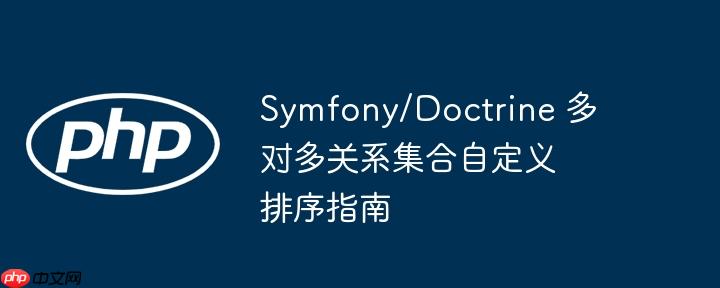
在现代Web应用开发中,数据实体之间存在复杂的关系是很常见的。多对多关系(Many-to-Many)是其中一种典型场景,例如一个产品可以属于多个分类,一个分类也可以包含多个产品。在 Symfony 和 Doctrine ORM 中,这种关系通常通过一个中间表(或称关联表)来映射。
虽然 Doctrine 能够自动处理这些关联的加载,但在某些业务场景下,我们可能需要对从这些关联中获取的集合数据进行特定的排序。例如,当获取某个产品的所有分类时,我们希望这些分类是按照它们在产品中的重要性或展示顺序进行排列的。本文将探讨如何利用 Doctrine 的注解功能,优雅地实现这种自定义排序,而无需手动编写复杂的查询。
假设我们有两个实体:Product(产品)和Category(分类),它们之间是典型的多对多关系。为了映射这种关系,我们创建了一个中间表 product_categories,其中包含 product_id、category_id 以及一个额外的 serial_number 字段,用于存储特定产品下分类的排序序号。
以下是初始的实体注解(使用 PHP 8+ Attributes 语法,旧版 Doctrine 亦支持 @ORM\ 注解):
Product 实体
// src/Entity/Product.php
<?php
namespace App\Entity;
use Doctrine\Common\Collections\ArrayCollection;
use Doctrine\Common\Collections\Collection;
use Doctrine\ORM\Mapping as ORM;
#[ORM\Entity]
class Product
{
#[ORM\Id]
#[ORM\GeneratedValue]
#[ORM\Column]
private ?int $id = null;
// ... 其他字段 (例如 name)
/**
* @var Collection<int, Category>
*/
#[ORM\ManyToMany(targetEntity: Category::class, mappedBy: 'products')]
private Collection $categories;
public function __construct()
{
$this->categories = new ArrayCollection();
}
public function getId(): ?int
{
return $this->id;
}
public function getCategories(): Collection
{
return $this->categories;
}
public function addCategory(Category $category): static
{
if (!$this->categories->contains($category)) {
$this->categories->add($category);
$category->addProduct($this);
}
return $this;
}
public function removeCategory(Category $category): static
{
if ($this->categories->removeElement($category)) {
$category->removeProduct($this);
}
return $this;
}
}Category 实体
// src/Entity/Category.php
<?php
namespace App\Entity;
use Doctrine\Common\Collections\ArrayCollection;
use Doctrine\Common\Collections\Collection;
use Doctrine\ORM\Mapping as ORM;
#[ORM\Entity]
class Category
{
#[ORM\Id]
#[ORM\GeneratedValue]
#[ORM\Column]
private ?int $id = null;
#[ORM\Column(type: 'string', length: 255)]
private ?string $name = null;
/**
* @var Collection<int, Product>
*/
#[ORM\ManyToMany(targetEntity: Product::class, inversedBy: 'categories')]
#[ORM\JoinTable(name: 'product_categories')]
#[ORM\JoinColumn(name: 'category_id', referencedColumnName: 'id')]
#[ORM\InverseJoinColumn(name: 'product_id', referencedColumnName: 'id')]
private Collection $products;
public function __construct()
{
$this->products = new ArrayCollection();
}
public function getId(): ?int
{
return $this->id;
}
public function getName(): ?string
{
return $this->name;
}
public function setName(string $name): static
{
$this->name = $name;
return $this;
}
public function getProducts(): Collection
{
return $this->products;
}
public function addProduct(Product $product): static
{
if (!$this->products->contains($product)) {
$this->products->add($product);
}
return $this;
}
public function removeProduct(Product $product): static
{
$this->products->removeElement($product);
return $this;
}
}现在,我们的目标是当通过 $product-youjiankuohaophpcngetCategories() 获取一个产品的分类集合时,结果应该根据 product_categories 表中的 serial_number 字段进行排序。
用户尝试了以下注解:
// 尝试在 Category 实体中排序 Product 集合 #[ORM\OrderBy(["product_categories.serial_number" => "DESC"])] private Collection $products; // 或在 Product 实体中排序 Category 集合 #[ORM\OrderBy(["product_categories.serial_number" => "DESC"])] private Collection $categories;
这些尝试导致了以下问题:
用户的核心问题是:如何在不为 product_categories 中间表创建独立实体和仓库的情况下,通过注解实现这种排序?
#[ORM\OrderBy](或 @ORM\OrderBy)是 Doctrine ORM 提供的一个强大注解,用于为实体关联的集合定义一个默认的隐式排序规则。其主要特点包括:
根据 Doctrine 官方文档的说明:
#[ORM\OrderBy] acts as an implicit ORDER BY clause for the given fields, that is appended to all the explicitly given ORDER BY items. All collections of the ordered type are always retrieved in an ordered fashion.
这意味着,#[ORM\OrderBy] 会尝试根据集合中每个成员(即目标实体实例)自身的字段进行排序。
为了实现用户希望的排序效果,即通过 serial_number 字段对 $product->getCategories() 结果进行排序,我们需要确保 serialNumber 字段存在于 Category 实体中。虽然原始问题指出 `
以上就是Symfony/Doctrine 多对多关系集合自定义排序指南的详细内容,更多请关注php中文网其它相关文章!

每个人都需要一台速度更快、更稳定的 PC。随着时间的推移,垃圾文件、旧注册表数据和不必要的后台进程会占用资源并降低性能。幸运的是,许多工具可以让 Windows 保持平稳运行。

Copyright 2014-2025 https://www.php.cn/ All Rights Reserved | php.cn | 湘ICP备2023035733号